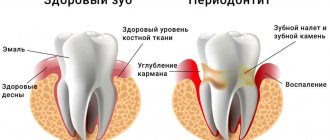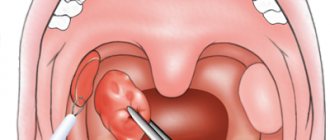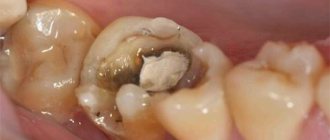Imagine that you have a slight toothache. Think about what you usually do in such a situation. Most people take painkillers and hope it's nothing serious. And only two out of ten people will immediately make an appointment with the dentist.
Yes, there are situations when there is no time for dental treatment. But the inflammatory process will not wait until you are free. Caries gradually but quickly develops into deep tissue lesions. The result is deplorable - a damaged tooth. And then a person is often inclined to think that the destructive process has gone too far and it is better to immediately remove the affected tooth.
We advise you not to draw your own conclusions!
To decide whether to treat a tooth or remove it, the patient must consult a dentist. Only a doctor, after a thorough examination and x-ray, can correctly assess the situation and make the right decision.
Remember that tooth extraction is an extreme form of treatment! Modern dentistry is aimed at saving the tooth. After all, a well-treated tooth can serve for a long time, and you will always have time to place an implant.
Case 2. Perforation of the tooth canal.
Also often referred to are patients whose tooth canal was unfilled and treated by the so-called. “blindly”, without sufficiently enlarging the surgical area. In this case, the dentist’s instrument could come off the hard material of the canal and cause damage to the root canal - perforate it. In this case, two foci of inflammation occur:
- the first focus of inflammation occurs at the root apex due to an untreated root canal,
- the second focus of inflammation occurs in the area of canal perforation.
The doctor recommends tooth extraction, but in such a situation it is also possible to avoid extraction and save the tooth!
How to do it right:
Contact a clinic that uses a powerful dental microscope in medical practice. Is the tooth removed in this case? - No.
Using a dental microscope, the doctor can look into the root canal, see all the filling material, carefully remove it, unfill the root canal, treat the perforation area, reach both sites of inflammation, eliminate the inflammation and fill both the canal and the previously caused perforation.
Thus, we save the patient’s tooth without resorting to unnecessary removal.
Extraction of problematic eights
Most often, molars initially have an incorrect position or are bent during the process of formation. When asking a specialist whether “it’s worth pulling out a tooth,” keep in mind that such elements must be eliminated. Without timely surgical intervention, they can interfere with the normal functioning of neighboring units, destroy their root system, lead to the curvature of an entire row of teeth and the development of harmful bacteria in the oral cavity.
Removal is a complex process. First of all, the doctor cuts the gum and moves it back. Then he carefully loosens and “turns” the figure eight using an elevator. Often, initially he has to saw the crown with a drill, which involves further extraction in parts. Only after all necessary actions have been completed, the dentist proceeds to suturing.
Case 3. An instrument broke in the canal
We often come across cases when patients come to us who, during treatment in other clinics, have had a broken instrument in the root canal.
But the patient has no idea about this, since the attending physician himself did not notice it. When treating inflammation, in the absence of a microscope at hand, this remaining instrument interferes with the full treatment of the root canal. And the doctor, without seeing this instrument, cannot remove it, making full root canal treatment possible. Therefore, the patient is recommended to have the tooth removed. But is it necessary to remove the tooth in this case? - No.
How to do it right:
Contact a clinic that has a dental microscope in its arsenal.
Under high magnification, the doctor will be able to see the problematic root canal and see the remaining fragment of the instrument. Then carefully remove it, treat the root canal and eliminate inflammation. This allows the patient to save the tooth without having to remove it. Effective treatment of the above situations has become possible thanks to the use of dental microscopes in dental practice. Don’t skimp on your dental health; go to clinics that are equipped with microscopic treatment technologies.
Features of the structure of wisdom teeth
The structure of a wisdom tooth is no different from other molars and consists of a neck, a root system (4–5 pieces) and a crown. In some cases, root development is disrupted and a single conglomerate is formed, that is, a tooth grows with one root.
Its only difference from its neighbors is that recent studies recognize the wisdom tooth as a rudiment that has lost its functional purpose during the evolutionary development of man. Scientists do not consider it as a full-fledged organ, since some part of humanity does not grow it at all.
However, the wisdom tooth has several parameters that distinguish it from the same “seven”:
- lack of milk precursors, which ultimately complicates eruption and impedes growth. There is no room left for it on the dental arch, which is why various developmental pathologies arise;
- the number of roots is greater than that of other molars - up to 5 pieces. In this regard, problems often arise when removing a wisdom tooth;
- significantly curved roots of the “eights” make cleaning and treatment of root canals very difficult;
- poor blood supply compared to other teeth leads to rapid aging, accompanied by fragility and susceptibility of tissues to caries, despite minimal load;
- many pathological conditions, for example, pathologies of the masticatory muscles, malocclusion, pericoronitis, are associated with the growth of “eights”.
Thus, the appearance of third molars has many more negative consequences than positive ones. Many patients are forced to see a dentist even before they can be seen in person.
Case 4. The source of inflammation at the root of the tooth - the so-called. cyst
Imagine the situation.
A tooth that previously did not have a filling or was previously treated endodontically begins to hurt. An examination is carried out, X-ray control is done, but often a more informative cone-beam computed tomography CBCT or, as many say, a 3D x-ray is performed. A dental cyst is detected. The doctor recommends removing the tooth because there is a large area of inflammation at the top of the tooth root, caused by an infection in the root canal. The infection gets beyond the root tip and causes inflammation. This inflammation can be treated by removing the infection from the root canal. It is easier for a doctor who does not have the knowledge and treatment methods to remove a tooth.
How to do it right:
There is no need to remove the tooth. In the case of a dental cyst, it is necessary to carry out diagnostics, examination and high-quality treatment under the control of an operating microscope with isolation of the working field, followed by hermetically sealed restoration of the tooth at the stage of endodontic treatment. The recommendation is simple:
before removing a tooth, consult a professional. You may not need tooth extraction! This means that sinus lifting, implantation and prosthetics procedures following the removal will not be necessary.
Complex wisdom tooth removal
During such an operation, the surgeon uses many more instruments and performs more complex manipulations, in particular, cutting soft tissues and suturing the incision without fail.
Complex removal is carried out if:
- we are talking about removing the lower wisdom tooth;
- there is an abnormal root system;
- the coronal part is severely destroyed;
- impacted, dystopic molars.
Preparation for the operation follows approximately the same pattern as for simple wisdom tooth removal, but this is where the similarities end. This is noticeable already at the initial stage: more time is allocated for the effects of anesthesia - about 10 minutes.
Is it painful to remove a wisdom tooth?
Many patients delay wisdom tooth removal due to fear of pain. Such fears in modern dentistry are absolutely groundless, since anesthetics are necessarily used for the procedure. Discomfort occurs when the effect of the drugs wears off and the analgesic effect decreases. But this is a physiological process that fades away on its own after some time. In addition, there is absolutely no need to endure pain; the doctor will prescribe medications to alleviate the postoperative condition.
When removing a wisdom tooth, some patients experience painful symptoms for a number of reasons:
- drug addiction;
- extensive purulent process;
- abuse of painkillers.
Also, the degree of pain depends on the method of removal, the condition of the wisdom tooth, and its location. For example, surgery on the upper jaw is easier. But removing a wisdom tooth from the lower jaw is more problematic due to the structural features of the jaw and large curved roots.
Is it possible to cure a complex case or is it better to remove the diseased tooth?
The question sounds like “to be or not to be” in our perception!
A little 30 years ago, dentists did not have the same opportunities as they do now, and saving a tooth was possible in rare cases.
Nowadays, technology makes it possible to save teeth in a seemingly hopeless situation, and only resort to surgical help at the very end.
The reason why we try to save teeth is the deformation of the dentition, which in any case will follow the loss of a tooth, to one degree or another.
Recovery can be different, sometimes it is enough to grind the bone tissue and remove interfering areas, sometimes bone grafting is necessary for subsequent rational prosthetics. But, of course, there are always certain boundaries beyond which only tooth extraction is possible as a solution to the problem.
Indications for tooth extraction:
- The acute stage of periodontitis, in which there is intractable, (non-passing) purulent inflammation, and other acute purulent processes, in which removal is performed in 100% of cases (osteomyelitis, phlegmon).
- A fracture of the tooth root, in the middle third or in the apical part, in which it is impossible to perform tooth-preserving operations.
- Temporary teeth, which have their own range of indications, have been repeatedly described in a number of previous articles.
- Significant destruction of the crown part of the tooth, in which its restoration is impossible.
- Dystopia, retention of the eighth teeth.
- Root caries, that is, the penetration of an infectious process into the area of the tooth root.
- Injuries in which the tooth is located in the fracture zone, where it can become a secondary infectious agent.
The factors we have listed are local contraindications to surgery; there are also general reasons that do not allow tooth extraction surgery to be performed under standard conditions:
- Acute infectious process.
- A history of myocardial infarction lasting less than six months, or other cardiovascular pathologies requiring special training and subsequent dental procedures.
- Less than six months history since the last radiation therapy session.
- Bleeding disorders, blood diseases.
Each of these factors requires the dentist to conduct specialized training before surgery and choose an adequate method of treatment.
If, however, we have an adequate clinical picture that allows us to fight for the tooth, then the appropriate treatment options will be offered to you. Each case is individual; not only your oral condition matters, but also the body’s reactivity and the performance of your immune system.
Let's look at one of the clinical cases for clarity:
The patient came with acute pain due to the fracture of part of the tooth, namely the palatal wall of the 24th tooth.
On the first visit, an examination was performed, the movable wall was removed and a temporary filling was placed. After which a CT scan was performed for information.
On a CT scan we found teeth in a state of granulating periodontitis; unfortunately, there were quite a few of them.
After consultation with an orthopedic dentist and therapist, a decision was made to remove teeth 18,17,16,24,25,26,27,36,37 due to the prevalence of the inflammatory process in the bone tissue. In the pictures you can assess the condition of the teeth.
In the photographs you can also notice inflammatory phenomena in the maxillary sinus, which are of odontogenic (dental) origin.
In turn, we really want to try to cure and leave tooth number 46.
It is also necessary to remember about the possibilities of tooth-preserving operations, which allow extending the life of the tooth during therapeutic preparation and surgical solution of the problem. Unfortunately, in the clinical case we presented, it was impossible to carry out tooth-preserving techniques.
Thus, it is important to understand that treatment options have expanded and the decision to save your tooth will be made from the point of view of an integrated approach.
How does socket healing proceed after tooth extraction?
The healing process goes like this:
- After a wisdom tooth is removed, a socket filled with blood is formed. Within 2 hours, the blood clots and a blood clot is formed, which is necessary to protect the wound from infection. The postoperative socket at this time has a dark red color.
- In the first 2-3 days, the blood clot decreases in size, darkens and thickens. The process of formation of granulation tissue begins, which is necessary for the restoration of the gum mucosa.
- Within three days to a week, the clot lightens and becomes whitish. Young connective tissue fills the hole almost entirely. At the same time, pain and swelling completely disappear.
- On days 7-10, the thrombus resolves, and the hole with light granulation tissue decreases in size. The process of bone tissue formation begins, which completely fills the defect within six months.
- After 15 days, superficial healing is complete, the gums are covered with a pink mucous membrane.
Thus, the postoperative wound usually heals within 2 weeks. Recovery from a complex wisdom tooth extraction may take longer as the tissue is usually more damaged. The healing time is also influenced by the condition of the oral cavity, the presence of infectious diseases, individual characteristics of the body, and correct adherence to medical recommendations.
Stages of healing
Norm and pathology
Immediately after extraction, the patient does not feel anything, as the effect of the anesthetic continues. As the effect of the drug wears off, pain of moderate intensity appears. Normally, they completely disappear no later than three days.
After wisdom tooth removal, swelling of the gums is possible, especially if the soft tissues were significantly injured during the operation. Within three days, the swelling goes away without causing much discomfort.
The blood stops within half an hour, a blood clot forms, completely covering the hole, so there should be no bleeding during normal healing. However, if you touch a clot, slight bleeding may occur.
The listed phenomena are natural for the postoperative period and should not cause concern. Reasons for urgently contacting a doctor are:
- Intense pain that increases over time. If the gums hurt very much after wisdom tooth removal for more than three days, and analgesics do not help, an inflammatory process is likely.
- Persistent swelling of the gums and the development of swelling of the face on the operated side are also symptoms of inflammation.
- Bleeding that lasts several hours or re-opens after stopping indicates vascular damage.
- Elevated body temperature is a sign of infectious inflammation, which is fraught with serious complications.
- A deep empty hole covered with a yellow-gray coating with a bad odor indicates alveolitis, an inflammatory complication.
- Purulent discharge from a wound, especially in combination with pain and swelling, is a sign of tissue infection.
- Runny nose and nasal discharge are the result of perforation of the maxillary sinuses during surgery.
- Paresthesia - numbness of the cheeks, tongue, lips, after the anesthesia has worn off, indicates nerve damage.











